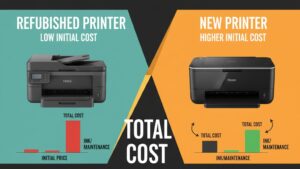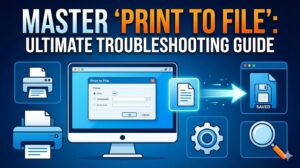Introduction
Reduce ink and toner usage effectively to slash your printing expenses and transform your budget. With ink cartridges costing more per ounce than champagne, finding smart ways to conserve these precious resources has become essential for families and businesses alike.
The average household spends over $300 annually on printer supplies, while offices can spend thousands. This staggering expense stems from inefficient printing habits, poor quality settings, and lack of maintenance knowledge that leads to unnecessary waste.
Smart strategies to reduce ink and toner usage can cut your printing costs by 40-60% without sacrificing document quality. These proven methods require minimal effort but deliver maximum savings, making professional printing affordable for everyone.
What Is Ink and Toner Usage Optimization?
Ink and toner usage optimization refers to strategic practices designed to minimize cartridge consumption while maintaining acceptable print quality for your specific needs. This concept encompasses technical settings, behavioral changes, and equipment maintenance that collectively reduce supply costs.
The process involves understanding how different print modes, paper types, and document formats affect consumption rates. Draft mode printing can reduce ink usage by 50%, while proper font selection saves up to 30% compared to ink-heavy alternatives.
Modern printers offer sophisticated controls for managing resource consumption. Eco-modes, grayscale printing, and duplex settings provide immediate conservation benefits. Understanding these features enables users to make informed decisions about when to prioritize quality versus economy.
Optimization also includes external factors like cartridge selection, paper quality, and printer maintenance. Compatible cartridges, high-quality papers, and regular cleaning cycles contribute significantly to efficient resource utilization and extended equipment lifespan.
The financial impact of optimization strategies compounds over time. Small daily savings accumulate into substantial annual reductions, making this knowledge invaluable for budget-conscious consumers and cost-aware businesses seeking operational efficiency improvements.
9 Powerful Strategies to Reduce Ink and Toner Usage

Strategy 1: Master Print Quality Settings
Switch to draft or fast mode for internal documents, emails, and rough drafts. These settings use 40-50% less ink while maintaining readability for everyday business communications and personal printing needs.
Reserve high-quality settings exclusively for client presentations, photos, and final documents. This selective approach balances professional appearance with resource conservation, maximizing value from expensive cartridge investments.
Strategy 2: Choose Ink-Efficient Fonts Wisely
Select fonts like Century Gothic, Calibri, or Times New Roman that require minimal ink coverage. Avoid bold, italic, or decorative fonts unless absolutely necessary for document formatting or branding requirements.
Reduce font sizes when possible without compromising readability. Smaller text uses proportionally less ink while often improving document layout and information density per page.
Strategy 3: Optimize Margins and Spacing
Adjust page margins to fit more content per sheet while maintaining professional appearance. Reducing margins from 1 inch to 0.75 inches can accommodate 15-20% more text per page.
Use single spacing instead of double spacing for internal documents. This simple change reduces page count significantly while maintaining document clarity and reducing both paper and ink consumption.
Strategy 4: Embrace Grayscale Printing
Print in grayscale (black and white) for documents that don’t require color. This approach preserves expensive color cartridges for essential applications like presentations, marketing materials, and photographs.
Configure grayscale as your default setting for everyday printing. Most business documents, reports, and correspondence function perfectly without color, making this an effortless conservation method.
Strategy 5: Preview Before Printing
Always use print preview to check layout, formatting, and page count before sending jobs to your printer. This practice prevents waste from formatting errors, unwanted pages, and unnecessary reprints.
Remove unnecessary pages, images, or sections that don’t add value to your document. Careful editing before printing eliminates waste while improving document focus and clarity.

Strategy 6: Maintain Your Printer Regularly
Clean printheads monthly to ensure optimal ink flow and prevent waste from poor print quality. Clogged nozzles force printers to use more ink to achieve acceptable results, increasing consumption unnecessarily.
Replace cartridges promptly when quality deteriorates. Running cartridges until completely empty can damage printheads and lead to expensive repairs that far exceed cartridge replacement costs.
Strategy 7: Choose Compatible Cartridges Strategically
Research high-quality compatible cartridges that offer 60-80% savings over original equipment manufacturer (OEM) options. Many compatible cartridges provide comparable quality and page yields at fraction of the cost.
Buy in bulk when possible to achieve additional savings. Compatible cartridge suppliers often offer significant discounts for multiple cartridge purchases, further reducing per-page printing costs.
Strategy 8: Implement Double-Sided Printing
Enable duplex printing as your default setting to reduce paper consumption and associated ink usage for multi-page documents. This approach cuts supply costs while reducing storage space requirements.
Manually flip pages for printers without automatic duplex capability. While less convenient, manual double-sided printing still provides substantial savings for longer documents and reports.
Strategy 9: Use Print Management Software
Install print monitoring software to track usage patterns and identify waste sources. These tools provide detailed analytics on consumption trends, helping you make informed decisions about printing habits.
Set print quotas and implement approval processes for large jobs. Controlled printing environments reduce unnecessary usage while maintaining productivity and document quality standards.

Advanced Tools and Techniques for Maximum Savings
Print management solutions like PaperCut, PrintFleet, and EveryonePrint offer sophisticated tracking and control features. These platforms enable detailed cost allocation, usage monitoring, and automated policy enforcement across multiple devices and users.
Third-party ink refill services provide substantial savings for high-volume users. Professional refilling maintains cartridge quality while reducing costs by 70-80% compared to new cartridge purchases.
Continuous ink supply systems (CISS) offer the ultimate solution for heavy users. These systems replace traditional cartridges with large external reservoirs, reducing per-page costs to pennies while maintaining print quality.
Consider laser printers for high-volume black and white printing. Toner cartridges offer significantly lower per-page costs than inkjet cartridges, making them ideal for document-heavy environments despite higher upfront equipment costs.
Common Mistakes That Increase Ink and Toner Costs
Using Incorrect Paper Types
Wrong paper selection forces printers to use more ink to achieve proper saturation and color accuracy. Cheap, porous papers absorb excessive ink while producing poor results that often require reprinting.
Invest in printer-specific paper recommendations from manufacturers. Quality papers optimized for your printer type deliver better results with less ink consumption, providing superior value despite higher paper costs.
Ignoring Printer Maintenance
Neglecting regular cleaning cycles leads to clogged printheads that waste enormous amounts of ink during automatic cleaning processes. These cleaning cycles can consume 15-20% of cartridge capacity each time they run.
Schedule monthly maintenance routines including head cleaning, nozzle checks, and alignment procedures. Proactive maintenance prevents major consumption spikes and extends both cartridge and printer lifespan significantly.
Printing Everything Immediately
Impulsive printing without careful consideration leads to unnecessary waste from unwanted pages, formatting errors, and duplicate documents. This reactive approach can double actual printing needs through poor planning.
Implement a digital-first workflow with printing as a final step only when physical documents are truly necessary. Review, edit, and optimize all documents digitally before committing to paper and ink consumption.
Buying Cheap Cartridges Without Research
Extremely low-cost cartridges often provide poor page yields, causing frequent replacements that eliminate apparent savings. These cartridges may also damage printers or produce unacceptable print quality.
Research compatible cartridge suppliers thoroughly, reading reviews and comparing page yield specifications. Quality compatible cartridges provide genuine savings while maintaining performance and reliability standards.
Frequently Asked Questions
Q: How much money can I really save by following these tips to reduce ink and toner usage? A: Most users save 40-60% on printing costs by implementing these strategies consistently. Draft mode alone reduces ink consumption by half, while compatible cartridges provide additional 60-80% savings on supply costs.
Q: Will using draft mode make my documents look unprofessional? A: Draft mode is perfect for internal communications, rough drafts, and reference materials. Reserve high-quality settings for client-facing documents, presentations, and final reports to balance professionalism with cost savings.
Q: Are compatible cartridges safe for my printer warranty? A: High-quality compatible cartridges from reputable suppliers are safe and won’t void your warranty. However, avoid extremely cheap options that might cause damage or poor performance issues.
Q: How often should I clean my printer to reduce ink and toner usage effectively? A: Perform basic cleaning cycles monthly and deep cleaning quarterly. Regular maintenance prevents waste from clogged nozzles and ensures optimal ink efficiency throughout your cartridge’s lifespan.
Conclusion
Learning to reduce ink and toner usage effectively transforms your printing budget while maintaining document quality and productivity. These nine proven strategies can cut your supply costs by 40-60% through simple settings changes, smart purchasing decisions, and regular maintenance practices.
The key to success lies in making conservation automatic through proper default settings, quality cartridge selection, and consistent maintenance routines. Small daily changes compound into substantial annual savings that make professional printing affordable for everyone.
Start implementing these money-saving techniques today by switching to draft mode, choosing ink-efficient fonts, and enabling grayscale printing as defaults. Your wallet and your printer will thank you for these intelligent conservation strategies.
Remember that the most effective approach combines multiple strategies rather than relying on single solutions. Consistent application of these principles ensures maximum savings while preserving the printing quality your work demands.
Eco-Friendly Printing Tips: Revolutionary Ways to Save Money & Planet Read More.




